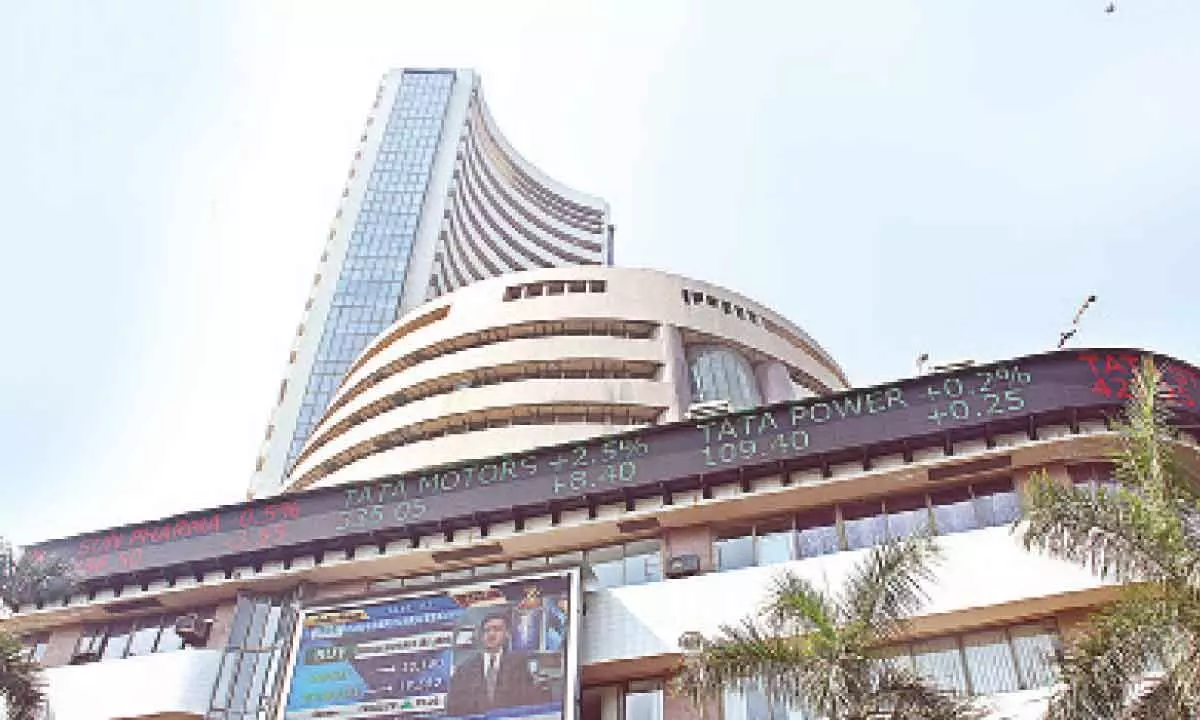Investors chary of directionless market

Nifty, which ended a 2-week consolidation phase (16,800-17,200), may take a breather around 17,400 before marching to 17,600 points
Buoyed by the recovery in global equity markets, easing worries over banking sector's health, renewed FII buying, strong GST collections and optimism over possible pause or modest hike in interest rates by RBI; the domestic stock market snapped a three-week losing streak and gained more than two percent during the week ended. BSE Sensex added 1,464.42 points or 2.5 percent, to end at 58,991.52 points, while NSE Nifty rose 414.75 points or 2.44 percent to close at 17,359.80 points. The BSE Mid-cap index added two per cent and the BSE Small-cap index rose 0.7 percent. On the sectorial front, Nifty PSU bank index rose four percent, information technology index 2.7 per cent, metal index 2.3 per cent and the Pharma index gained 2.2 percent. It is pertinent to understand that in March, the BSE Smallcap index shed only 1.4 percent, but as many as nearly 200 stocks declined up to 41 percent.
Defence stocks took centre stage after the Ministry of Defence (MoD) has placed orders worth Rs44,240 crore on local manufacturers, benefiting the entire domestic supply chain. FIIs turned net buyers during the week, buying equities worth Rs2,243.74 crore, while DIIs bought Rs4,955.78 crore worth of shares. In March FIIs bought equities worth Rs1,997.70 crore and DIIs Rs30,548.77 crore. The Nifty, which ended a two-week consolidation phase (16,800-17,200), may take a breather around 17,400 before marching to 17,600. Amid all the positivity, market participants shouldn't go overboard and focus on stock selection.
Near-term direction of the market will be dictated by both the US and our own domestic inflation data, impact of OPEC meet on international crude oil prices, RBI policy meeting outcome and other global cues. Though the US Fed commentary refrained from appearing Dovish, traders began unwinding rate hike bets factoring in the banking crisis. Recovery in China appears to be strengthening further in the month of March, after stringent pandemic restrictions were dropped and Covid infection waves eased. While the week gone by was a truncated one, the coming week is even shorter. We just have three trading days as Tuesday and Friday are trading holidays on account of Mahavir Jayanti and Good Friday, respectively.
Listening Post: Where Did This 'Bull Market' Come From, Anyway? Investors talk about bull markets, especially the current one that took birth during Covid times, but nobody seems to agree on a definition or where the term came from. Everybody talks about bull and bear markets, especially the current one, often called the longest bull market in history starting from bottoms of 2008 crisis. But nobody seems to agree on an exact definition, or knows where the prevailing ones originated, including many investment professionals. Analysts often say that a bull market is defined by a 20 per cent rise from a market index's most recent lowest point; a bear market, a 20 per cent decline from its latest high. Variations on that are countless—and endlessly confusing. Only by looking back at the history of these terms can you can get a better sense of what they mean, why they matter and how you should factor them into your thinking.
The use of bull and bear refer to financial optimists and pessimists, respectively, originated in Britain in the early 18th century. Bull evoked the bellowing of an eager buyer. Bear appears to have come from an early proverbial expression, to sell the bear's skin before one has caught the bear—an apt metaphor for a short sale, in which a trader sells borrowed shares in hopes of buying them back at a lower price.The terms bull market and bear market, however, didn't arise until the 1850s. For decades, bull and bear markets referred not to long-term moves in the stock market as a whole, but to ephemeral price action in a single asset. The 20 per cent threshold for bull and bear markets began to take hold only in the latter 1950s and early 1960s. The 20 per cent threshold took a long time to gain traction, however. Only after the epic performance of the 1980s and 1990s, when stocks delivered roughly 18 per cent average annual returns, did the definitions with a 20 per cent threshold take hold for good.
Where does all this leave investors? First, realize how arbitrary the terms bull market and bear market are. No one knows why the definitions don't include a minimum length of time. Or why they're usually based on closing prices instead of intraday highs and lows. Or who came up with the 20 per cent threshold and why it wasn't 25 per cent or 30 per cent or 41.2879 per cent. (Defining a correction as a 10 per cent decline is equally arbitrary). Investors always want more precision than the collective mood swings of markets tend to offer. In this case, the fact that the recent decline was just shy of 20 per cent appears to have given investors the confidence that the market hadn't entered bear territory—and changed their behaviour. The more you know about financial history, the less surprised you should be by how bull and bear markets unfold.
Quote of the week
The stock market is filled with individuals who know the price of everything, but the value of nothing. — Phillip Fisher That is another testament to the fact that investing without an education and research will ultimately lead to regrettable investment decisions. Research is much more than just listening to popular opinion.
F&O/ SECTOR WATCH
Mirroring the recovery in broader market, the settlement week and the last week of the financial year saw broader indices recover and close in green. In the option segment, the highest Open Interest concentration in Calls was seen at 17,700 strike, shifting from 17,500 strike, while on the Put side highest Open Interest concentration was held at 17,000 followed by 17,300 strike. Implied Volatility (IV) of Calls closed at 12.45 per cent, while that for Put options closed at 13.08 per cent. The Nifty VIX for the week closed at 13.63 per cent. PCR of OI for the week closed at 1.18 lower than the previous week. From the technical front, Nifty is still trading below its 200-day Exponential Moving Average on daily charts, whereas Bank Nifty managed to close above its 200-day Exponential Moving Average. 'Buy the dip' will remain in favour and any correctional fall close to 17,200-17,150 will provide an opportunity to build fresh long positions.
Bank Nifty is also set to gain more momentum as most of the major components witnessed a breakout to the upside, turning near-term bias sideways higher. A fresh round of buying will emerge with potential targets of 41,300-41,500 which if broken decisively will open the room for 42,000 and above. Expect Banking stocks to outperform the market with biasness likely to remain in favour of bulls. India's passenger vehicle sales rose 27 per cent to a record 3.9 million units in the last fiscal year. Industry volumes were buoyed by strong sales at the top three automakers — Maruti Suzuki, Hyundai Motor India and Tata Motors — all of them reporting their highest fiscal-year sales. Buoyed by an increase in the minimum support prices (MSP) that boosted farm income, coupled with another year of above-normal monsoon, tractor sales in India - the world's largest market for tractors - hit a record high of 944,000 units in 2022-23, up 12 per cent on year. Stay overweight on automobile sector. Stock futures looking good are HDFC Bank, Indian Hotels, Kotak Mahindra Bank, ICICI Bank, Mannapuram Finance and TVS Motors.Stock futures looking weak areDeepak Nitrate, Gujarat Gas, IEX, McDowell, Voltas and Vedanta.
STOCK PICKS
Eris Lifesciences Ltd is the only publicly listed Indian Pharmaceutical company with a pure-play domestic branded formulations business model. Ranked 22 in the IPM, Eris has established an esteemed market presence in its core cardio-metabolic franchise in just 15 years since inception. Business of the company is highly focused – 93 per cent of business comes from chronic and sub-chronic therapies.Oral diabetes care is the flagship therapy contributing to 32 per cent of FY 22 revenue. Over the years the company has created a strong full-service presence across all the OHA segments – Sulphonylureas, DPP4 Inhibitors and SGLT 2 Inhibitors. The company has entered in the Rs3,500 crore insulin market with the launch of human insulin through our subsidiary Eris MJ Biopharm Ltd. Cardiac Care is the second largest therapy area, contributing 28 per cent of our business. Eris is ranked #4 in terms of prescription rank among Cardiologists and #9 in terms of revenue in the Cardiac Care space.
(The author is a senior stock market analyst and former vice-chairman of AP Planning Board)














